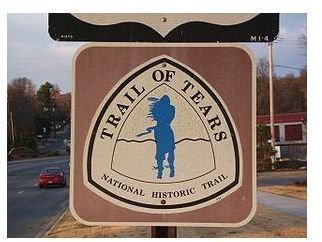Trail of Tears Webquest: The Indian Removal Act
The Indian Removal Act
For decades, if not longer, the white settlers were in conflict with the American Indians over land ownership. On May 26, 1830, Congress
passed the Indian Removal Act. The act gave the government permission to remove the Indians from their traditional lands and relocate them to what is now Oklahoma. The Trail of Tears refers to the forced march of 17,000 Cherokee over 2,000 miles. During the trip, more than 4,000 men, women and children died.
Task
It is 2030, and your group has been commissioned to design a monument to those who suffered and died on the Trail of Tears, to be erected in the nation’s capital in commemoration of the bicentennial of the Indian Removal Act. Through the Trail of Tears webquest, you will gather information about the events and the people involved.
Your monument must explain the conflict and the struggle on the Trail to those who may never have heard of it. It should include a timeline of the events, as well as a map of the trails, including descriptions of the terrain and the weather at the time of the trek. The monument should capture the attention of visitors and lead them to a clear understanding of the Indian Removal plan and the Trail of Tears.
You will need to produce a model of your monument and a brochure to explain the monument to visitors to the site. Include the actual monument itself, as well as any landscaping that would accompany it. Add a legend to the model to explain any symbolism you include.
Process
Each member of the group will have an assigned research task for the first part of the Trail of Tears webquest project.

The mapmaker will create a topographical map that shows the routes taken by the Indians on their forced march; he or she will also write a description of the geographic features, the weather and the impact of each of these on the journey.
The timeliner will create a visual element that describes the important events related to the Indian Removal movement, including the dates and the people or groups involved.
The graphic artist will locate pictures, and write captions describing the contents of those pictures, that communicate the hardships faced by those who walked the Trail of Tears.
Use these websites to locate the information that you will need for this portion of your project:
National Park Service: Trail of Tears–History & Culture
This site will explain what the Trail of Tears is, as well as giving you information on the places along the Trail of Tears and virtual museum exhibits.
The Trail of Tears Across the Mississippi Valley
On this site, you will find historical information about the Cherokee, Indian removal policies, and the routes taken, along with a description of traveling the trail.
Cherokee–North Carolina: Trail of Tears
The site provides information about the people involved with the Trail of Tears, including John Ross and Andrew Jackson.
Sequoyah Research Center: Family Stories from the Trail of Tears
Oral histories from families who traveled the Trail of Tears are archived on this site.
Museum of the Cherokee Indian: The Trail of Tears
This site includes an interactive map that tells about various locations along the trail.
Two Documents on Indian Removal
This site includes information about the Worcester v. Georgia (1832) Supreme Court case and biographical information about Andrew Jackson.
You may also use Google Images to search for pictures.
Drawing Your Conclusions
When your group has completed its research, brainstorm ways in which you can share the information with those who will visit the monument. Draw your plans before you begin building the model.
Create a three-fold brochure to place around the monument for people to take with them to read about the Trail of Tears. Your brochure should be visually appealing and free of spelling or grammar errors.
Having completed the Trail of Tears webquest, you should be able to use your model to explain to other students why the Trail of Tears is an important part of American history, as well as the lessons from the time that apply to modern society.
References
- The ideas for this project come from the author’s classroom teaching experience.
